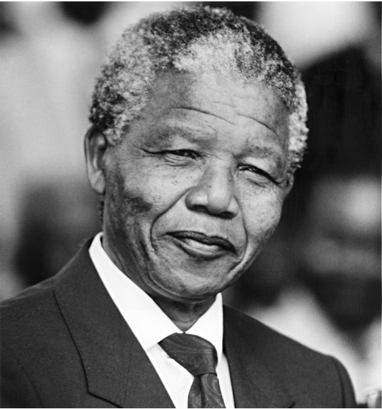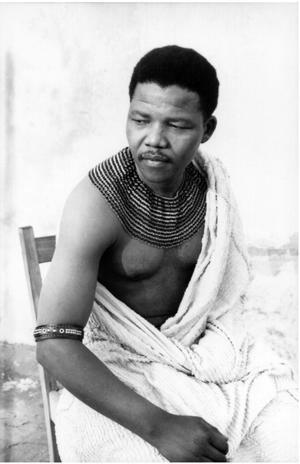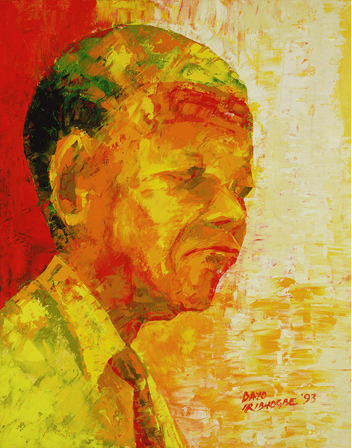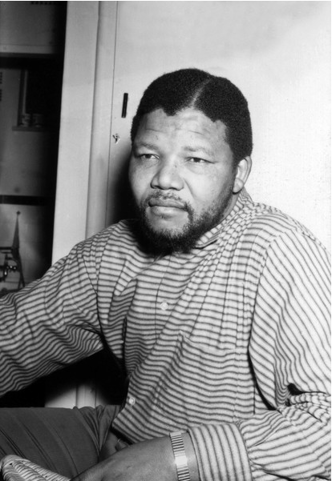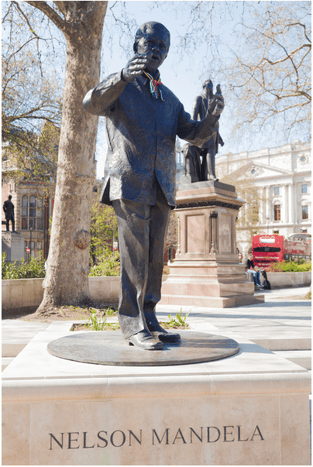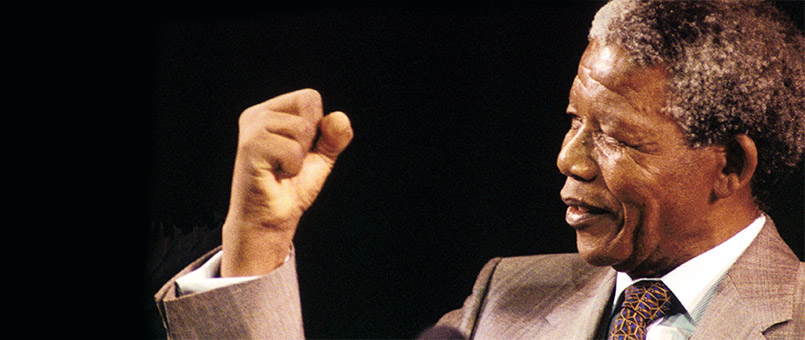
Happy Birthday Nelson Mandela
18th July 1918, is the birth date of one of the most influential leaders of our time. Nelson Mandela, who is arguably the most important person in bringing about the end of Apartheid, the winner of the Nobel Peace Prize and the 1st black president of South Africa, certainly deserves celebrating.
Early Life and Career
Rolihlahla Mandela (later named Nelson by his school teacher in accordance with the tradition of giving the children a ‘Christian’ name), was born in the village of Mvezo, into the Madiba clan. His father, Nkosi Mphakanyiswa Gadla Mandela, was the principal counsellor to the Acting King of the Thembu people, Jongintaba Dalindyebo. After the death of his father, Mandela was placed under the care of Jongintaba Dalindyebo, who was his father’s cousin.
Later, Mandela began studying for a Bachelor of Arts at the University College of Fort Hare (a university for Coloured, African and Indians), however he was expelled for protesting about the election process of the Student Representative Council. When told that the Chief had arranged marriages for them, Nelson and his cousin, Justice, ran away to Johannesburg. Arriving in 1941, Mandela became an articled clerk at the firm of Witkin, Sidelsky and Eidelman. Here he met Communists and attended their meetings, however he never joined as its Atheism conflicted with his Christian faith.
Entering Politics
In 1843, Mandela met Anton Lembede, an African National Congress member who believed that black Africans should be independent in their struggle for equal rights. Mandela agreed with this philosophy and decided that the ANC needed a youth sector in order to mass-mobilise Africans to fight for the end of their repression. The ANCYL was set up in 1944 on Easter Sunday. The South African General Election in 1948 (where only whites could vote), elected the Herenigde Nasionale Party that was openly racist. The party soon passed the Apartheid Legislation that expanded the racial segregation in South Africa. In response to this, Mandela, who was gaining influence in the ANC (as wells as others) encouraged direct action against this legislation, advocating strikes and boycotts in an attempt to gain full citizenship for black South Africans.

Apartheid in South Africa : policemen blockading anti-segregation demonstration and asking the demonstrators to disperse May 12, 1961
In 1952, Mandela was also an important leader in the ANC’s Campaign for the Defiance of the Unjust laws, organising protests, as well as promoting their manifesto – The Freedom Charter. Mandela and his old friend, Oliver Tambo also set up South Africa’s first African law firm Mandela and Tambo, providing affordable legal service to those affected by the apartheid.
With Mandela and 155 other activists put on trial for treason in 1956, tensions rose in the ANC (despite the fact that all were acquitted 1961), causing a militant faction, the Pan Africanist Congress (PAC), to split off. The following year, tensions rose with 69 people being killed at a peaceful protest in Sharpeville, causing riots and anger. The government banned the ANC and PAC, convincing Mandela that a more radical approach was needed. As consequence, he set up Umkhonto we Sizwe (aka MK), an armed sector of the ANC.
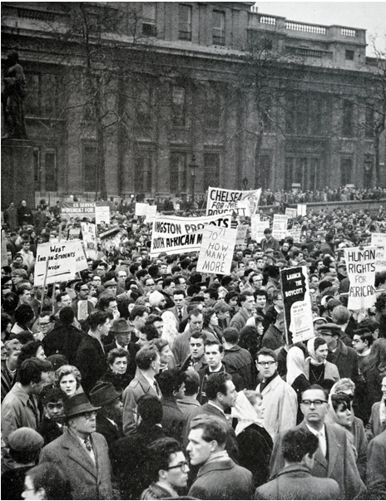
Protesters in Trafalgar Square against the Sharpeville Massacre, 1950 / Universal History Archive/UIG
Mandela’s Arrests
On August 5th, 1962, Mandela was arrested and sentenced to 5 years in prison. This was due to the fact that he illegally left the country to attend a conference in Ethiopia with African nationalist leaders and visited Oliver Tambo who was exiled in London, the South African government found further fault with the fact that he underwent guerilla training in Algeria and incited a worker’s strike in 1961. However, in July of the following year, the police raided an ANC hideout in a suburb of Johannesburg called Rivonia, and found evidence implicating Mandela and a group of others, and they were put on trial for treason, sabotage and violent conspiracy. Mandela and seven others were subsequently sentenced to life imprisonment.
Mandela’s Imprisonment
Mandela’s first 18 years of imprisonment were spent in Robben Island Prison, situated off the coast of Cape Town, a former leper colony. The conditions were terrible, punishments brutal, and Mandela was forced to do hard labour in a lime quarry. However, while imprisoned, Mandela gained a law degree from the University of London, mentored other inmates and encouraged peaceful protest. He smuggled out political statements and wrote the first drafts of his autobiography – ‘A long Walk to Freedom’.
During his time in prison, Mandela remained a public figure. Oliver Tambo’s ‘Free Nelson Mandela’ campaign (1980), raised Mandela’s publicity, causing an international outcry for his release and an end to racism in South Africa. With the mounting pressure, the government offered Mandela’s release in exchange for various compromises which Mandela rejected.
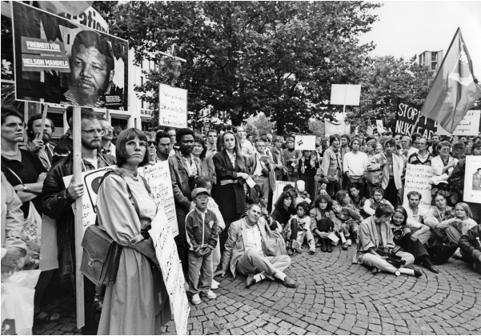
Germans demonstrating for Nelson Mandela to be freed from prison (b/w photo) / © SZ Photo / Karl-Heinz Egginger
In 1982, Mandela was moved to Pollsmoor Prison, and later in 1988, he was placed under house arrest in a minimum security correctional facility. On February 11th, 1990, the newly elected President F. W. de Klerk, called for Mandela’s release, having lifted the ban on the ANC, and called for a non-racist South Africa.
Mandela’s Presidency
After his release, Mandela led the ANC in their talks with the National Party, in an attempt to end apartheid and obtain a multiracial government. These talks gained Mandela and de Klerk the Nobel Peace Prize in December 1993. In 1994, Mandela and the ANC were elected as the majority party in the 1st multiracial parliamentary elections that took place on April 26th, with Mandela as the 1st black president of South Africa, and de Klerk as his deputy.
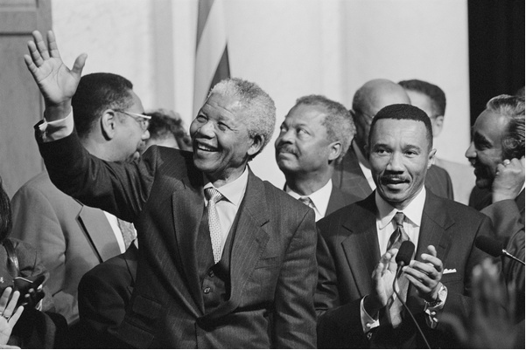
President of South Africa, Nelson Mandela with members of the Congressional Black Caucus. Oct. 4, 1994. Standing beside Mandela is Rep. Kweisi Mfume (born Frizzell Gerald Gray), Maryland Congressman / Photo © Everett Collection
During his presidency, Mandela did huge amounts to improve the living standards of black South Africans, end discrimination and advocate human rights. Mandela aimed to create a “rainbow nation at peace with itself and the world.” He retired from politics in 1999 and was replaced by his deputy Thabo Mbeki.
Legacy
During his later years, Mandela remained devoted to campaigning for peace and social justice. He set up the Nelson Mandela Foundation and The Elders, who are a group of public figures dedicated to addressing global problems. Later, he became a supporter of AIDs awareness and treatment programmes, in an attempt to end stigma and ignorance about the disease that is extremely common in South Africa.
As he aged, Mandela began to gradually withdraw from public life, due to health problems and frailty. In 2009, the United Nations declared “Nelson Mandela International Day” on the 18th of July, in recognition of Mandela’s efforts to democracy, human rights and peace around the world.
Nelson Mandela died aged 95, on December 5th 2013.
Find out more
Contact us at uksales@bridgemanimages.com for more information on licensing and copyright.
View all images of Nelson Mandela in the archive.

